Geo-Design in Planning for Bicycling: An Evidence-Based Approach for Collaborative Bicycling Planning
Abstract
:1. Introduction
- -
- How can the geo-design approach support planning for bicycling?
- -
- What are the strengths and weaknesses of using geo-design approaches for bicycling planning?
- -
- How can a hybrid geo-design workshop be organized? What are the applicable methods and techniques?
2. Literature Review
3. Materials and Methods
3.1. Case Study of Sydney
3.2. Geo-Design Workshop Details
3.3. Data Collection and Applied Tools
3.3.1. Agent-Based Model and Simulation
3.4. Geo-Design in Action
- -
- Provision of integrating bicycling and public transport (bike-transit integration).
- -
- Provision of safe paths to school (strategies to increase bicycling and physical activity among youth).
- -
- Provision of providing appropriate bicycling infrastructure (bike stations, various path types, i.e., painted cycleways, separated and designed cycleways, and shared bike services, etc.).
- -
- Provision of bicycles for leisure, recreation, and tourism.
- -
- Provision of work/business close to home (balancing jobs and housing in the urban system).
- -
- Provision of required infrastructure for bicycling sharing systems.
- -
- Provision of improving real and perceived bicycling safety and provision of social infrastructure (programs and policies to increase bicycling).
4. Findings
5. Discussion
5.1. A Geo-Design Approach to Bicycling Planning
5.2. Limitations and Future Suggestions
6. Conclusions
Author Contributions
Funding
Institutional Review Board Statement
Informed Consent Statement
Data Availability Statement
Conflicts of Interest
Appendix A. Used Platforms
| 1 | This study is a chapter of broader research/dissertation for applying a geo-design and data-driven approach to planning for bicycling infrastructure. |
References
- United Nations. “68% of the World Population Projected to Live in Urban Areas by 2050, Says UN,” United Nations Department of Economic and Social Affairs. 2018. Available online: https://www.un.org/development/desa/en/news/population/2018-revision-of-world-urbanization-prospects.html (accessed on 1 January 2020).
- Infrastructure Australia. “Urban Transport Crowding and Congestion: The Australian Infrastructure Audit 2019. 2019. Available online: https://www.infrastructureaustralia.gov.au/sites/default/files/2019-08/Urban%20Transport%20Crowding%20and%20Congestion.pdf (accessed on 11 November 2019).
- Murphy, E.; Usher, J. The Role of Bicycle-sharing in the City: Analysis of the Irish Experience. Int. J. Sustain. Transp. 2015, 9, 116–125. [Google Scholar] [CrossRef]
- Porter, A.K.; Salvo, D.; Pérez, A.; Reininger, B.; Kohl, H.W. Intrapersonal and Environmental Correlates of Bicycling in U.S. Adults. Am. J. Prev. Med. 2018, 54, 413–418. [Google Scholar] [CrossRef] [PubMed]
- Pucher, J.; Garrard, J.; Greaves, S. Cycling down under: A comparative analysis of bicycling trends and policies in Sydney and Melbourne. J. Transp. Geogr. 2011, 19, 332–345. [Google Scholar] [CrossRef]
- Titze, S.; Stronegger, W.J.; Janschitz, S.; Oja, P. Association of built-environment, social-environment and personal factors with bicycling as a mode of transportation among Austrian city dwellers. Prev. Med. 2008, 47, 252–259. [Google Scholar] [CrossRef]
- Pucher, J.; Dill, J.; Handy, S. Infrastructure, programs, and policies to increase bicycling: An international review. Prev. Med. 2010, 50, S106–S125. [Google Scholar] [CrossRef] [PubMed]
- Stinson, M.A.; Bhat, C. Commuter Bicyclist Route Choice: Analysis Using a Stated Preference Survey. Transp. Res. Rec. J. Transp. Res. Board 2003, 1828, 107–115. [Google Scholar] [CrossRef]
- Rybarczyk, G.; Gallagher, L. Measuring the potential for bicycling and walking at a metropolitan commuter university. J. Transp. Geogr. 2014, 39, 1–10. [Google Scholar] [CrossRef]
- Turoń, K.; Sierpiński, G. Bike-sharing as a possibility to support Vision Zero. MATEC Web Conf. 2018, 231, 03005. [Google Scholar] [CrossRef] [Green Version]
- Topp, H.; Pharoah, T. Car-free city centres. Transportation 1994, 21, 231–247. [Google Scholar] [CrossRef]
- Dudziak, A.; Caban, J. The Urban Transport Strategy on the Example of the City Bike System in the City of Lublin in Relation to the COVID-19 Pandemic. LOGI—Sci. J. Transp. Logist. 2022, 13, 1–12. [Google Scholar] [CrossRef]
- City of Sydney. Inner Sydney Regional Bicycle Network: Demand Assessment and Economic Appraisal; AECOM: Sydney, Australia, 2010. [Google Scholar]
- Committe for Sydney. Making Sydney a Cycling City. 2021. Available online: https://sydney.org.au/wp-content/uploads/2021/05/Committee-for-Sydney-Making-Sydney-a-cycling-city-May-2021.pdf (accessed on 11 September 2022).
- NSW Government. Movement and Place. 2021. Available online: https://www.movementandplace.nsw.gov.au/ (accessed on 11 August 2022).
- The City of Sydney. Creating Pop-Up Cycleways in Sydney. 2021. Available online: https://www.cityofsydney.nsw.gov.au/building-new-infrastructure/creating-pop-up-cycleways-in-sydney (accessed on 11 August 2022).
- Transport for NSW. Pop-Up Transport. 2021. Available online: https://roads-waterways.transport.nsw.gov.au/projects/popup-covid-19-infrastructure/index.html (accessed on 11 August 2022).
- Australian Bureau of Statistics. Regional Population by Age and Sex. 2016. Available online: https://www.abs.gov.au/statistics/people/population/regional-population-age-and-sex/latest-release (accessed on 11 February 2022).
- Pucher, J.; Buehler, R. Making Cycling Irresistible: Lessons from The Netherlands, Denmark and Germany. Transp. Rev. 2008, 28, 495–528. [Google Scholar] [CrossRef]
- Ellison, R.B.; Greaves, S. Travel Time Competitiveness of Cycling in Sydney, Australia. Transp. Res. Rec. J. Transp. Res. Board 2011, 2247, 99–108. [Google Scholar] [CrossRef]
- Leao, S.Z.; Lieske, S.N.; Pettit, C.J. Validating crowdsourced bicycling mobility data for supporting city planning. Transp. Lett. 2017, 11, 486–497. [Google Scholar] [CrossRef]
- Koglin, T.; Rye, T. The marginalisation of bicycling in Modernist urban transport planning. J. Transp. Health 2014, 1, 214–222. [Google Scholar] [CrossRef] [Green Version]
- Pettit, C.J.; Hawken, S.; Ticzon, C.; Leao, S.Z.; Afrooz, A.E.; Lieske, S.N.; Canfield, T.; Ballal, H.; Steinitz, C. Breaking down the silos through geodesign—Envisioning Sydney’s urban future. Environ. Plan. B Urban Anal. City Sci. 2019, 46, 1387–1404. [Google Scholar] [CrossRef]
- Tackling Wicked Problems: Through the Transdisciplinary Imagination; Harris, J.; Brown, V.A.; Russell, J. (Eds.) Routledge: London, UK, 2010. [Google Scholar] [CrossRef]
- Mayer, I.S.; van Bueren, E.M.; Bots, P.W.G.; van der Voort, H.; Seijdel, R. Collaborative Decisionmaking for Sustainable Urban Renewal Projects: A Simulation—Gaming Approach. Environ. Plan. B Plan. Des. 2005, 32, 403–423. [Google Scholar] [CrossRef]
- Steinitz, C. A framework for geodesign: Changing geography by design. In The People of the Place, Design Professions, Geographic Sciences, Information Technologies, 1st ed.; Esri Press: Redlands, CA, USA, 2012. [Google Scholar]
- Ervin, S. A system for GeoDesign. Proc. Digit. Landsc. Archit. 2012, 25, 145–154. [Google Scholar]
- Slotterback, C.S.; Runck, B.; Pitt, D.G.; Kne, L.; Jordan, N.R.; Mulla, D.J.; Zerger, C.; Reichenbach, M. Collaborative Geodesign to advance multifunctional landscapes. Landsc. Urban Plan. 2016, 156, 71–80. [Google Scholar] [CrossRef] [Green Version]
- Davis, J.; Pijawka, D.; Wentz, E.A.; Hale, M. Evaluation of community-based land use planning through Geodesign: Application to American Indian communities. Landsc. Urban Plan. 2020, 203, 103880. [Google Scholar] [CrossRef]
- Lenferink, S.; Arciniegas, G.; Samsura, A.; Carton, L. Integrating Geodesign and game experiments for negotiating urban development. Res. Urban. Ser. 2016, 4, 70–92. [Google Scholar] [CrossRef]
- Kuby, M.; Bailey, K.; Wei, F.; Fowler, J.; Tong, D.; Zhong, Q.; Lopez, O.; Sheaffer, W. Collaborative Geodesign for Alternative-Fuel Station Location using “Collablocation” Software. Transp. Res. Rec. J. Transp. Res. Board 2018, 2672, 98–108. [Google Scholar] [CrossRef]
- Kazak, J.K.; Garcia Castro, D.; Swiader, M.; Szewrański, S. Decision Support System in Public Transport Planning for Promoting Urban Adaptation to Climate Change. IOP Conf. Ser. Mater. Sci. Eng. 2019, 471, 112007. [Google Scholar] [CrossRef]
- Liu, Z.; He, C.; Yang, Y.; Fang, Z. Planning sustainable urban landscape under the stress of climate change in the drylands of northern China: A scenario analysis based on LUSD-urban model. J. Clean. Prod. 2019, 244, 118709. [Google Scholar] [CrossRef]
- Debnath, R.; Pettit, C.; Leao, S.Z.; Lock, O. The Role of Technology Tools to Support Geodesign in Resilience Planning. In Urban Informatics and Future Cities; Geertman, S.C.M., Pettit, C., Goodspeed, R., Staffans, A., Eds.; Springer: Cham, Switzerland, 2021; pp. 447–463. [Google Scholar] [CrossRef]
- De Oliveira, F.H.; Lazaro, J.C.; Moura, A.C.M.; Soares, M.C.; Braghirolli, G. Geodesign Experience in Florianópolis Metropolitan Region: Practical Planning with Different Professional Backgrounds. In Computational Science and Its Applications—ICCSA 2022 Workshops; Gervasi, O., Murgante, B., Misra, S., Rocha, A.M.A.C., Garau, C., Eds.; Springer: Cham, Switzerland, 2022; Volume 13379, pp. 117–131. [Google Scholar] [CrossRef]
- Sandre, A.A.; Fruehauf, A.L.; Miyahara, A.A.L.; Rosa, A.A.; Maruyama, C.M.; Locoselli, G.M.; Candido, L.F.; Lombardo, M.A.; Coelho, M.A.; Murolo, R.P.; et al. Geodesign Brazil: Trees for the Metropolitan Area of São Paulo. In Computational Science and Its Applications—ICCSA 2021; Gervasi, O., Murgante, B., Misra, S., Garau, C., Blečić, I., Taniar, D., Apduhan, B.O., Rocha, A.M.A.C., Tarantino, E., Torre, C.M., Eds.; Springer: Cham, Switzerland, 2021; Volume 12954, pp. 463–475. [Google Scholar] [CrossRef]
- Moura, A.C.M.; Freitas, C.R. Co-creation of Ideas in Geodesign Process to Support Opinion and Decision Making: Case Study of a Slum in Minas Gerais, Brazil. In Innovation in Urban and Regional Planning; La Rosa, D., Privitera, R., Eds.; Springer: Cham, Switzerland, 2021; Volume 146, pp. 255–264. [Google Scholar] [CrossRef]
- Foster, K. Geodesign parsed: Placing it within the rubric of recognized design theories. Landsc. Urban Plan. 2016, 156, 92–100. [Google Scholar] [CrossRef] [Green Version]
- Planning Support Systems in Practice; Geertman, S.; Stillwell, J. (Eds.) Springer: Berlin/Heidelberg, Germany, 2003. [Google Scholar] [CrossRef]
- Lovelace, R.; Goodman, A.; Aldred, R.; Berkoff, N.; Abbas, A.; Woodcock, J. The Propensity to Cycle Tool: An open source online system for sustainable transport planning. J. Transp. Land Use 2017, 10, 505–528. [Google Scholar] [CrossRef]
- Kuzmyak, J.R.; Walters, J.; Bradley, M.; Kockelman, K.M. Estimating Bicycling and Walking for Planning and Project Development: A Guidebook; Transportation Research Board: Washington, DC, USA, 2014. [CrossRef] [Green Version]
- Larsen, J.; Patterson, Z.; El-Geneidy, A. Build It. But Where? The Use of Geographic Information Systems in Identifying Locations for New Cycling Infrastructure. Int. J. Sustain. Transp. 2013, 7, 299–317. [Google Scholar] [CrossRef]
- Nelson, T.; Ferster, C.; Laberee, K.; Fuller, D.; Winters, M. Crowdsourced data for bicycling research and practice. Transp. Rev. 2020, 41, 97–114. [Google Scholar] [CrossRef]
- Lißner, S.; Francke, A.; Becker, T. Modeling Cyclists Traffic Volume—Can Bicycle Planning benefit from Smartphone based Data? In Proceedings of the 7th Transport Research Arena TRA 2018, Vienna, Austria, 16–19 April 2018. [Google Scholar] [CrossRef]
- Larsson, M.; Silvano, A.P. Open Data for Bicycle Classification for Better Planning and Simulation, and for Better Detection from Motorized Vehicles (OpenBike-CD). SAFER. 2022. Available online: http://urn.kb.se/resolve?urn=urn:nbn:se:vti:diva-18781 (accessed on 11 August 2022).
- Ratanaburi, N.; Alade, T.; Saçli, F. Effects of stakeholder participation on the quality of bicycle infrastructure. A case of Rattanakosin bicycle lane, Bangkok, Thailand. Case Stud. Transp. Policy 2021, 9, 637–650. [Google Scholar] [CrossRef]
- Macmillan, A.; Connor, J.; Witten, K.; Kearns, R.; Rees, D.; Woodward, A. The Societal Costs and Benefits of Commuter Bicycling: Simulating the Effects of Specific Policies Using System Dynamics Modeling. Environ. Health Perspect. 2014, 122, 335–344. [Google Scholar] [CrossRef] [Green Version]
- Heath, B.L.; Hill, R.R. Some insights into the emergence of agent-based modelling. In Agent-Based Modeling and Simulation; Taylor, S.J.E., Ed.; Palgrave Macmillan: London, UK, 2014; pp. 32–44. [Google Scholar] [CrossRef]
- Stieler, D.; Schwinn, T.; Leder, S.; Maierhofer, M.; Kannenberg, F.; Menges, A. Agent-based modeling and simulation in architecture. Autom. Constr. 2022, 141, 104426. [Google Scholar] [CrossRef]
- Zare, P.; Leao, S.; Pettit, C.J.; Gudes, O. Agent-based modelling in planning for bicycling: Practice of using open data for simulation of cyclists’ movement in the urban environments. 2022. [Google Scholar]
- Macal, C.M.; North, M.J. Tutorial on agent-based modelling and simulation. J. Simul. 2010, 4, 151–162. [Google Scholar] [CrossRef]
- Crooks, A.T.; Heppenstall, A.J. Introduction to Agent-Based Modelling. In Agent-Based Models of Geographical Systems; Heppenstall, A.J., Crooks, A.T., See, L.M., Batty, M., Eds.; Springer: Dordrecht, The Netherlands, 2012; pp. 85–105. [Google Scholar] [CrossRef]
- Piatkowski, D.P.; Marshall, W. Not all prospective bicyclists are created equal: The role of attitudes, socio-demographics, and the built environment in bicycle commuting. Travel Behav. Soc. 2015, 2, 166–173. [Google Scholar] [CrossRef]
- Panter, J.; Heinen, E.; Mackett, R.; Ogilvie, D. Impact of New Transport Infrastructure on Walking, Cycling, and Physical Activity. Am. J. Prev. Med. 2015, 50, e45–e53. [Google Scholar] [CrossRef] [PubMed] [Green Version]
- Furth, P.G.; Mekuria, M.C.; Nixon, H. Network Connectivity for Low-Stress Bicycling. Transp. Res. Rec. J. Transp. Res. Board 2016, 2587, 41–49. [Google Scholar] [CrossRef] [Green Version]
- Dill, J. Bicycling for Transportation and Health: The Role of Infrastructure. J. Public Health Policy 2009, 30, S95–S110. [Google Scholar] [CrossRef] [PubMed]
- Tulu, G.S.; Hadgu, M.; Tarekegn, A. Bicycling in Addis Ababa, Ethiopia: Opportunities and challenges. J. Sustain. Dev. Transp. Logist. 2019, 4, 50–59. [Google Scholar] [CrossRef]
- Oteros-Rozas, E.; Martín-López, B.; Daw, T.M.; Bohensky, E.L.; Butler, J.R.A.; Hill, R.; Martin-Ortega, J.; Quinlan, A.; Ravera, F.; Ruiz-Mallén, I.; et al. Participatory scenario planning in place-based social-ecological research. Ecol. Soc. 2015, 20, 4. Available online: http://www.jstor.org/stable/26270296 (accessed on 11 August 2022). [CrossRef]
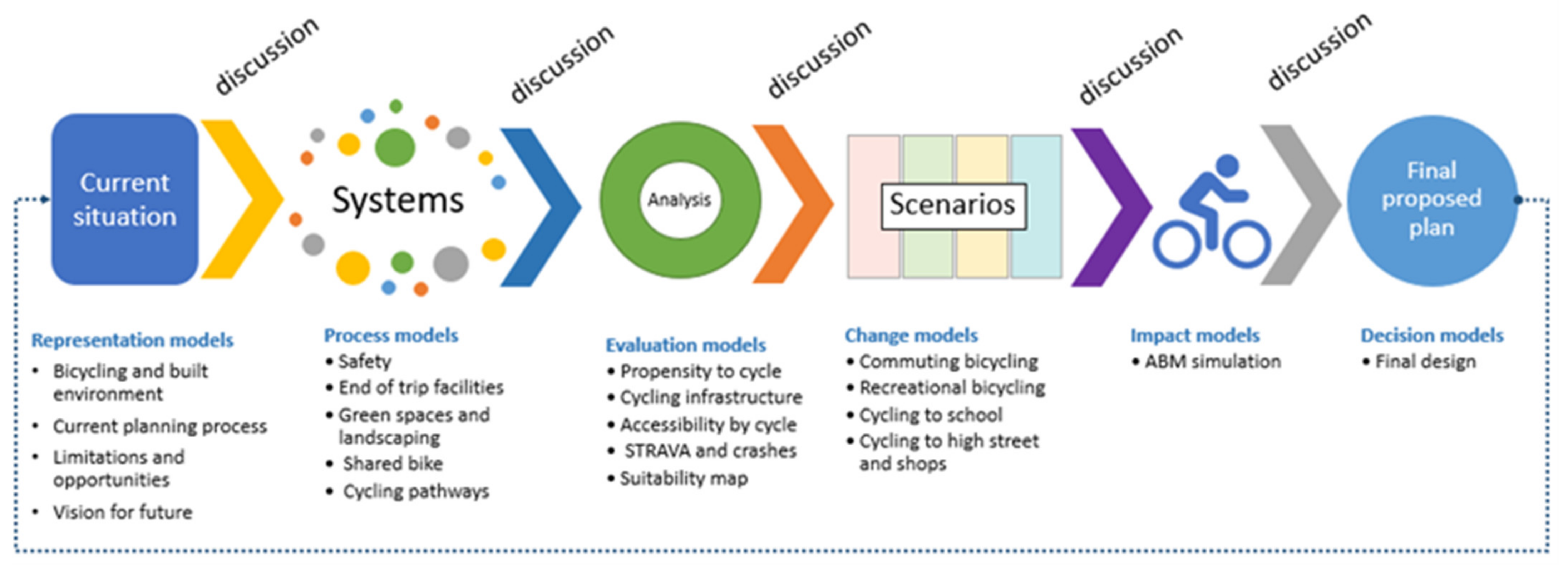
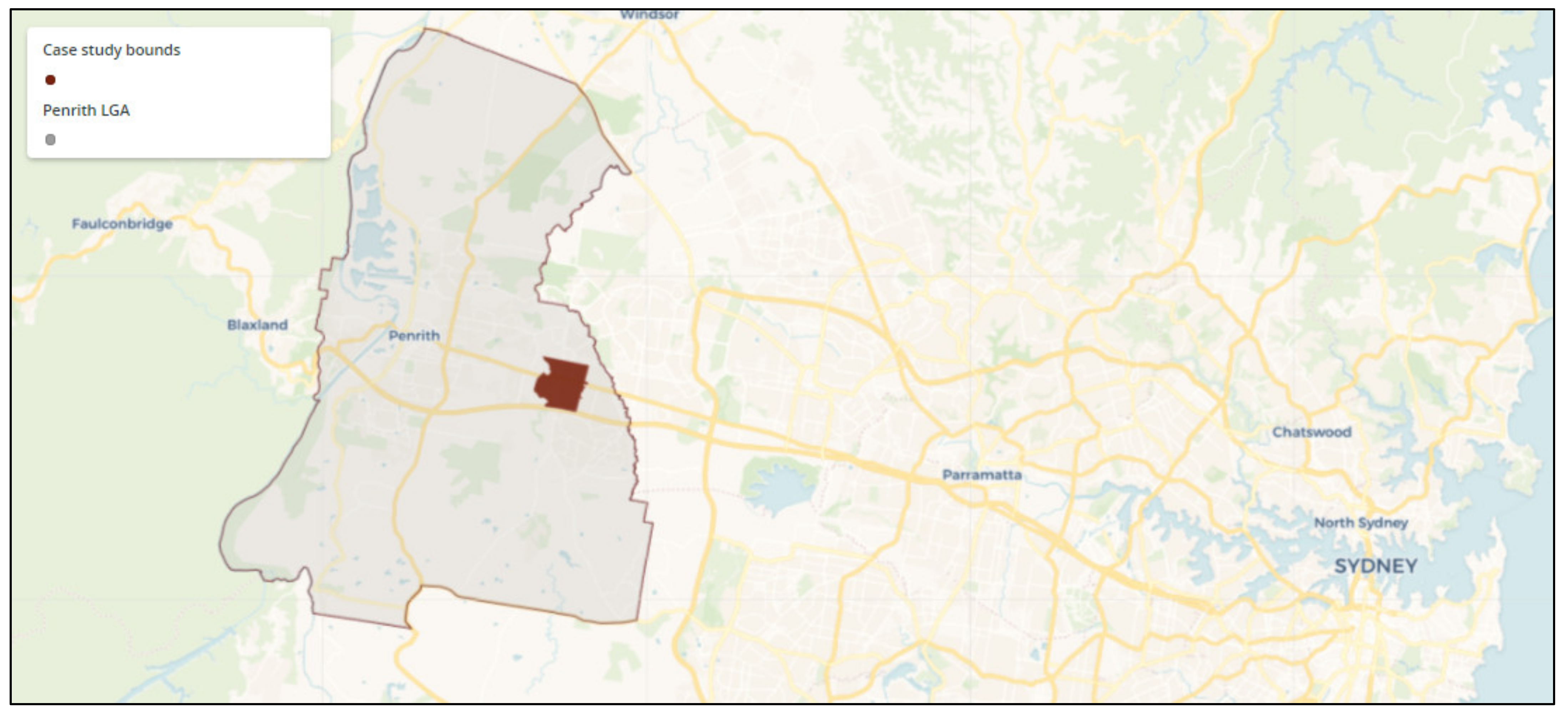



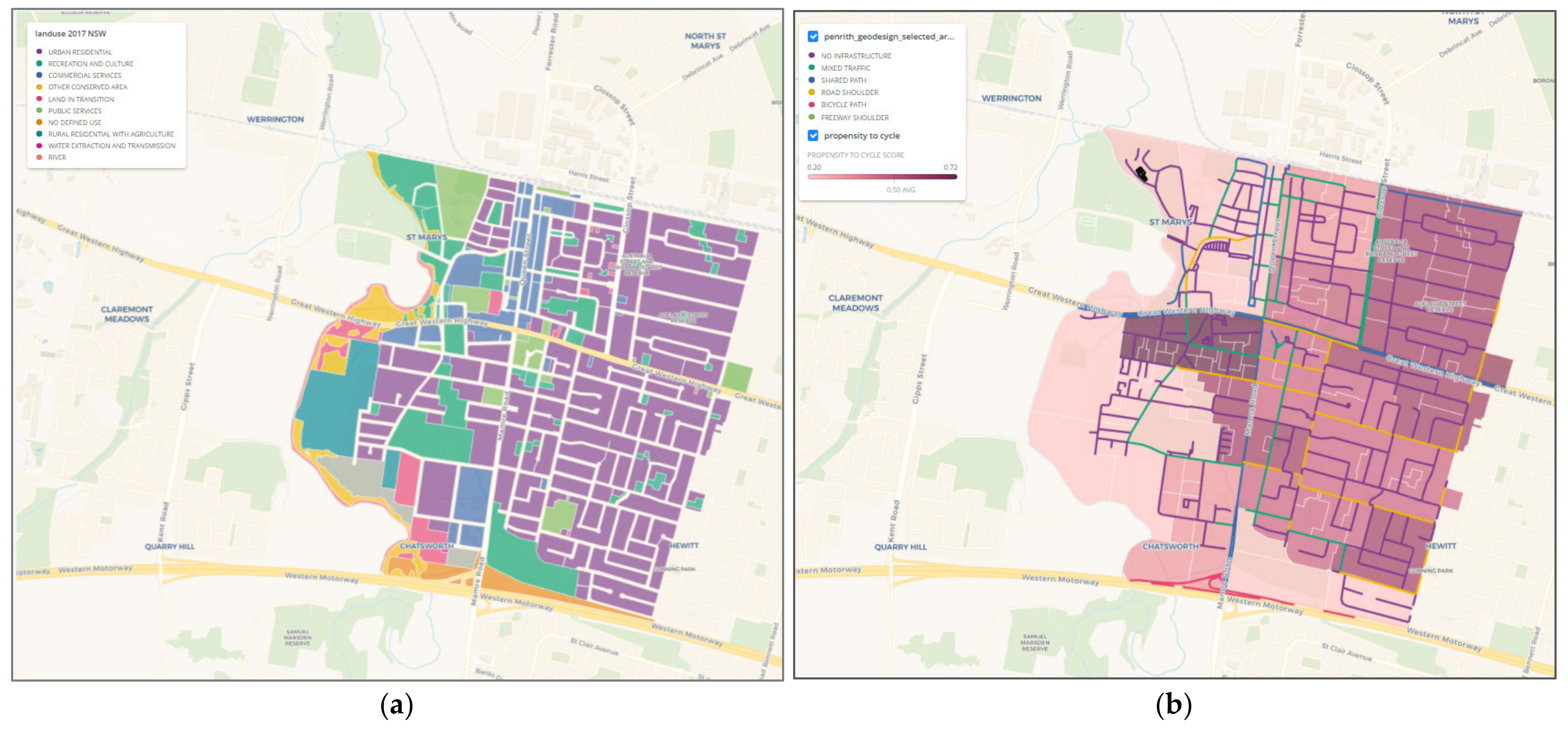
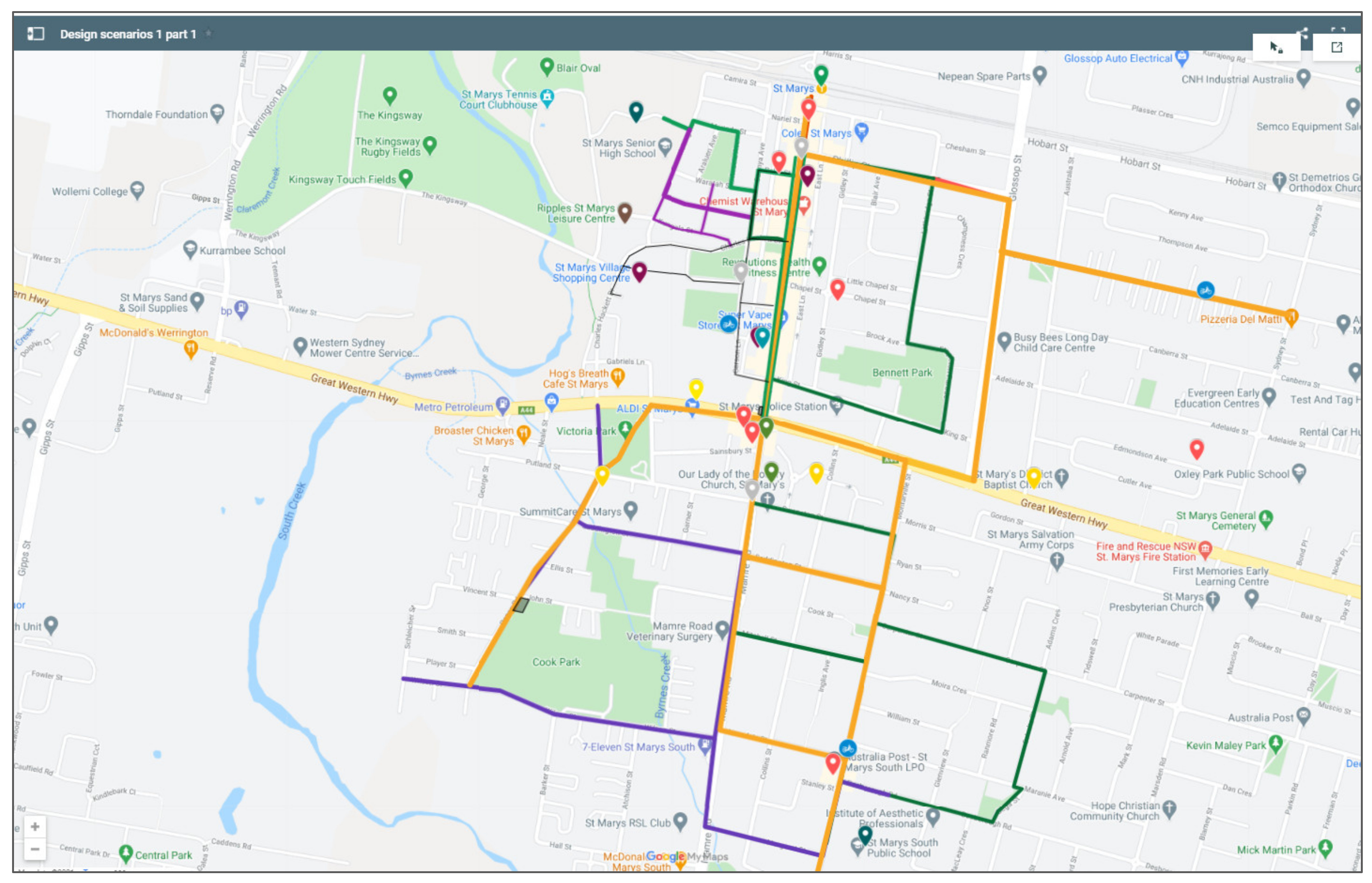
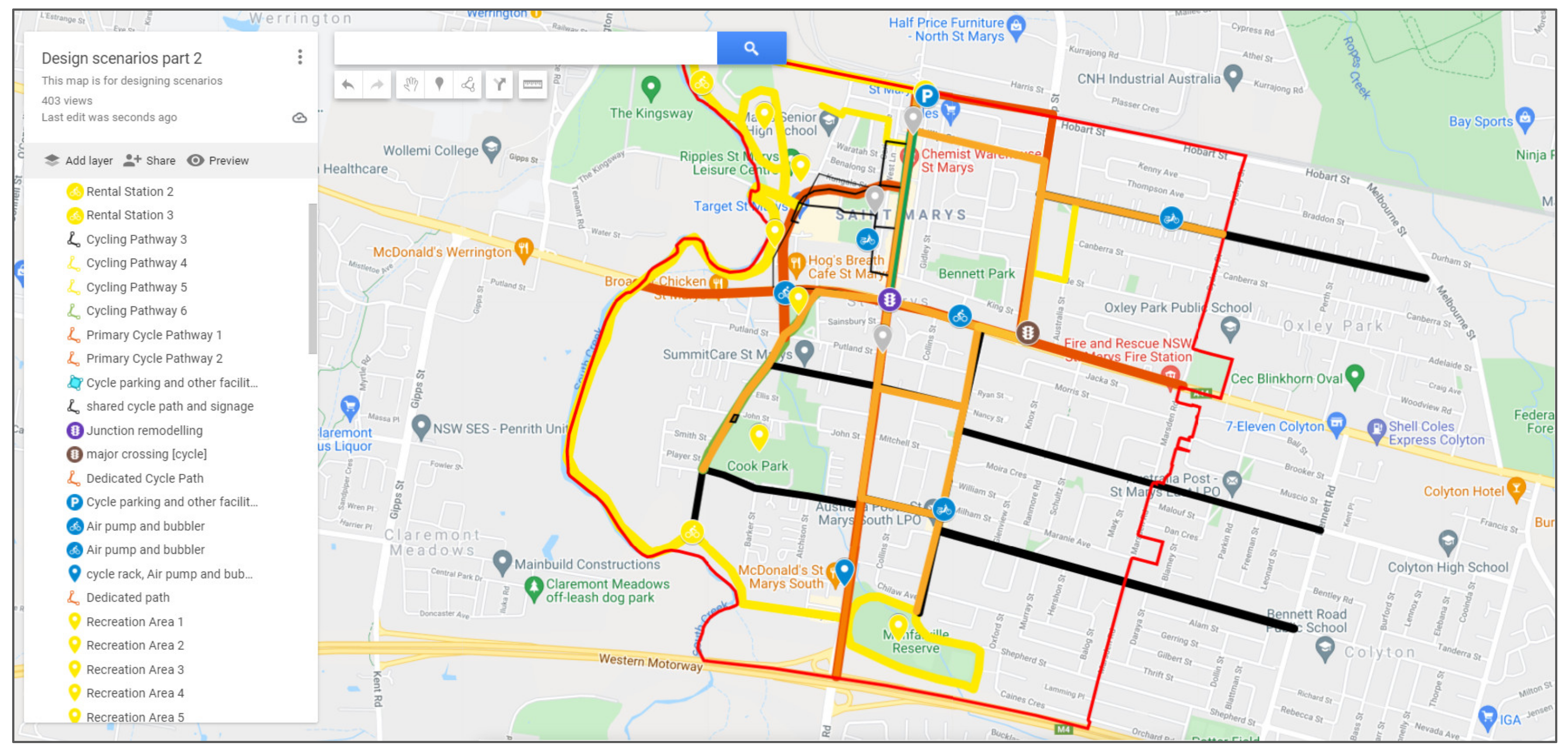
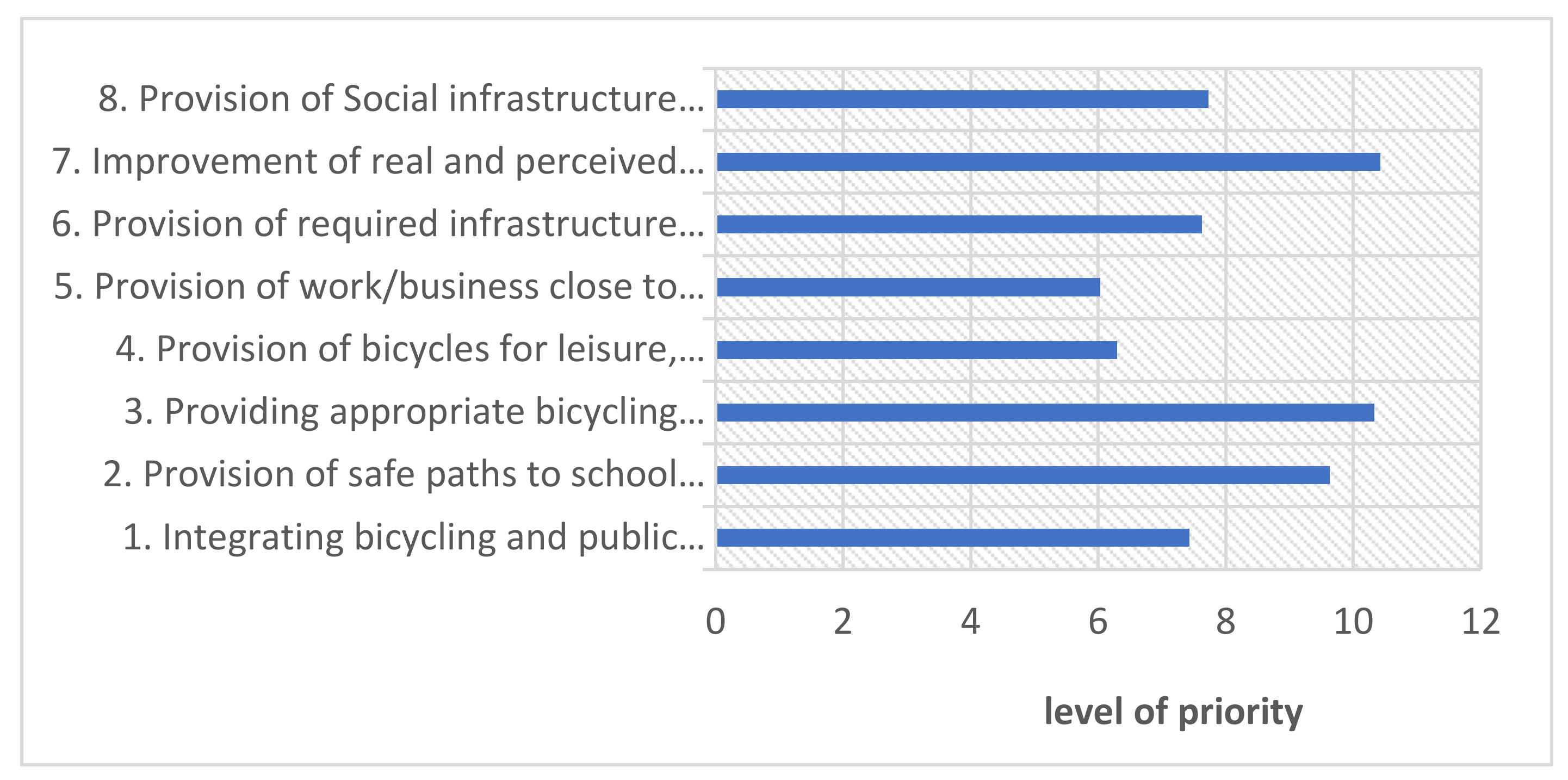
| Geo-Design Framework | Data Source | Application | Analysis Method |
|---|---|---|---|
| Representation model | Open Street Map | Road network | Network analysis |
| Infrastructure Cycleway Data (NSW) | Bicycling facility type | Network analysis | |
| Elevation—Elvis | Slope | Slope analysis | |
| Land use | Living and working places | Catchment analysis | |
| Australian Bureau of Statistics | Population demographics | Spatial analysis | |
| General Transit Feed Specification (GTFS) | Public transport stations | General Transit Feed Specification analysis | |
| Process model | Council strategic plan | Future structure plan Housing scheme | Spatial analysis |
| Australian Bureau of Statistics | Population projection | Spatial analysis | |
| Giraffe with the innovative NSW Spatial Services | Future and current development projects | Spatial analysis | |
| Evaluation model | Propensity to cycle (Open data—Transport NSW) | Willingness to use a bike | Spatial analysis |
| Accessibility by bike | Accessibility of main destinations by bike | Network analysis | |
| Strava | Bicycling counts | Spatial analysis | |
| Crash data—Road safety crash statistics NSW | Safety to ride a bike | Spatial analysis | |
| Change model | Google map places | Bicycling trip destinations | Spatial analysis |
| Infrastructure Cycleway Data (NSW) | Current bicycling facility type | Network analysis | |
| GTFS- Public transit stops and routes (ABM simulation) | Design scenario 1 | Catchment analysis | |
| Recreational centers—tree canopy | Design scenario 2 | ABM simulation | |
| Public schools—catchment area | Design scenario 3 | Catchment analysis—ABM simulation | |
| Land use and trip destinations | Design scenario 4 | ||
| Impact model | Number of bicyclists according to each design scenario | Design scenario impact assessment | ABM simulations |
| Decision model | Satisfaction of bicyclists from each design scenario according to the bicycling infrastructure | Design scenario impact assessment | ABM simulation statistical |
| Day | Geo-Design Model | Bicycling Planning Step |
|---|---|---|
| Day 1 | Representation model | Current situation study |
| Process model | Bicycling systems assessment | |
| Day 2 | Evaluation model | Analysis of the current situation |
| Change model | Design systems | |
| Day 3 | Change model | Design scenarios: Four scenarios |
| Impact model | Impact assessment: ABM | |
| Day 4 | Change model | Design scenarios: Two scenarios |
| Impact model | Impact assessment: ABM | |
| Decision model | Final proposed plan |
Publisher’s Note: MDPI stays neutral with regard to jurisdictional claims in published maps and institutional affiliations. |
© 2022 by the authors. Licensee MDPI, Basel, Switzerland. This article is an open access article distributed under the terms and conditions of the Creative Commons Attribution (CC BY) license (https://creativecommons.org/licenses/by/4.0/).
Share and Cite
Zare, P.; Pettit, C.; Leao, S.; Gudes, O.; Soundararaj, B. Geo-Design in Planning for Bicycling: An Evidence-Based Approach for Collaborative Bicycling Planning. Land 2022, 11, 1943. https://doi.org/10.3390/land11111943
Zare P, Pettit C, Leao S, Gudes O, Soundararaj B. Geo-Design in Planning for Bicycling: An Evidence-Based Approach for Collaborative Bicycling Planning. Land. 2022; 11(11):1943. https://doi.org/10.3390/land11111943
Chicago/Turabian StyleZare, Parisa, Christopher Pettit, Simone Leao, Ori Gudes, and Balamurugan Soundararaj. 2022. "Geo-Design in Planning for Bicycling: An Evidence-Based Approach for Collaborative Bicycling Planning" Land 11, no. 11: 1943. https://doi.org/10.3390/land11111943
APA StyleZare, P., Pettit, C., Leao, S., Gudes, O., & Soundararaj, B. (2022). Geo-Design in Planning for Bicycling: An Evidence-Based Approach for Collaborative Bicycling Planning. Land, 11(11), 1943. https://doi.org/10.3390/land11111943







